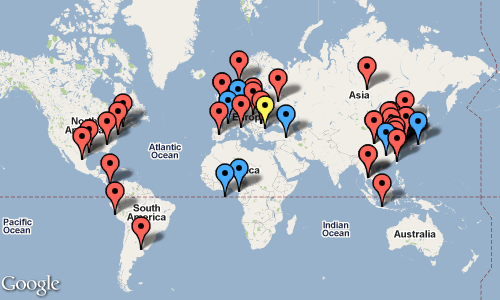I’ve been doing things very differently since I came back from the Startup Bus. Even before that I was writing up lists of technologies I wanted to try – but all there was to it, lists. Now I know one can indeed create something in a short time, so there’s no excuse to not actually trying all those tech. Here’s a little case study of what I’ve been doing in the last ~two weeks.
I had an idea for a game: I love quotations and reading a lot of Twitter I thought there could be a lot of “clevers” and “funnies” and “insightfuls” in there… I follow a lot of people and it is always interesting to see the different style people talk. So let’s take a bunch of people who others might know, find their tweets that make good quotation and let people guess who that tweet belongs to.
Yeah, that’s the whole thing. And all of it mostly made because 1) I like these kind of puzzles, 2) wanted to learn a bit of web app programming. Going ahead and looking at the result: Here it is, Who Said That? :

To summarize (mostly for my own education), here’s what I learned in the one week of development and in the one week since going live:
Behind the scenes
First I had to choose what technology it should all be based on. The two main contenders were Ruby on Rails and Django. I was reading a lot of pros and cons of both. I know that almost everyone I met on the Bus were doing Rails, and seen it myself too. On the other hand my go-to language to do things is Python. So they were on more-or-less equal footing. In the end I went with Django, because it is completely new to me and can have a little “niche” experience (not because not many people use Django, just not many who I know) that might come handy later. Also, there will be lots of other opportunities to try Rails in other projects. :)
I also wanted something hosted. Since Rails is out, Heroku is out too (that’s what everyone seems to be using, for a good reason, though I also didn’t want to spend money on it if I don’t have to). I also considered Google AppEngine which is not strictly Django but at least Python. I used before (and it is great at least on the small scale), so wanted to see if there’s any other hosting company out there. Fortunately there’s a startup that seems to be just the right thing for me: DotCloud. They are still in beta, but I got somehow an invite by talking to them on Twitter. They host Ruby, Python, Rails, Django, databases (MySQL, PostgreSQL, Redis), and more. One push deploy, roll-back, quite good docs, … and I love startups so why not help them too by testing their platform. :) So there it is: Django on DotCloud.
I also wanted to try a few different techs, like “can I use Redis for something in this project”? But that’s just the wrong way. Instead I should always ask: I want to do this or that: what’s the right tech for it? Using PostgreSQL and Django at the moment, though would think MongoDB would be a good fit too, but DotCloud does not have Mongo yet.
Getting interesting data
First I thought it will be quite easy, because people seemed to like the Twitter API. It was everything but… Now I learned to be much more careful of what I say: an API can be good for a lot of things, but to get exactly what I want can often mean a lot of wrangling, trial and error, and tweaking my own thought process to think in their developers’ way.
What did I want? “Quote-quality tweets”, that is: not a reply, not a retweet, not a link. Popularity (by some measure to be determined) is optional, but would be nice.
How did it go this time:
- “I want interesting Tweets from all kinds of folks, from everywhere!” (If you already know web development and my naivete start to make you sniggle at this point, I know, I know…) That looked like a perfect job for statuses/public_timeline. But that only pulls a couple of Tweets in.
- Then maybe the Streaming API? Well, I cannot have access to all the tweets (and probably I couldn’t handle of that traffic either). At my level (“Spitzer”) I can only have access to a random 1% of tweets. So I wrote a little app that was listening to the Stream and filtering tweets that looked like a good quote. I left that running the whole night. How many good tweets it collected? I think it was about 3 (yeah, single digit). How many of those were from people who anyone else would be interested? 0. Well, this failed again.
- [There was some more trial and error that I don’t remember very well…]
- Then had a spark: keep it simple. Instead of fishing in the big pond, let’s choose the interesting people first, and import what they are saying. Well, duh! So it can be even simpler: set up a Twitter user for the sole purpose of administration. Whoever that user follows will be in my database. Can also use Twitter lists to organize them and get some categories out (e.g. someone can be in Celebrity, Actors and Comedy in the same time). This also lends itself to easy administration within a Twitter interface, don’t have to roll my own.
So with this, I just had to figure out who to follow. At this point I mostly imported people who I know and I think they write well or interesting things.
- WeFollow is a good resource for categories and popular people
- Twitter’s own Who to follow
- Using the Similar people link when I added someone new
So far I have about 70-80 people in the database, giving more than 4000 useful quotes. Some people are better than other. I was surprised how many of them just post loads of links but almost no personal content (and these are the things I like to learn in a project like this).
In the end I had something simple working and I enjoyed using. Now let’s make it ready to open up.
Domain Name
This part I didn’t really have to but wanted to: putting it on it’s own domain. I mean the likes of “somethingsomething.dotcloud.com” is okay, but I wanted to be able to make short links to the game and that format doesn’t really leaves much space e.g. if I make a Tweet with a link…
Been looking for a name for the better half of two days. Lots of searching and getting inspiration from Domai.nr. I learned a couple of things. One idea was “Who Said It?”, but .it’s Italy does not let people with not EU addresses to register. GoDaddy goes around this restriction for an extra $19.99/year (they vouch for you or something) but that was just too much for me and I didn’t want to register with them anyways. I do have an EU permanent residence at the moment, but just didn’t want to risk it. There were a couple of other domain names that are restrictive in this sense, and in the end I went with Austria’s .at, for “saidth.at”. It’s okay, not too expensive (the prices very a lot between countries, before I though there’s a more-or-less common price). One thing I didn’t like about it, that now I’m registered with living in “Taiwan, Province of China”. Say WHAT? (Okay, let’s put politics aside, that’s for some other time).
Making it look something
Well, from the design of the page one thing is easy to tell: I’m not a designer. I know I should make something simple, clean (because that’s what I like to use as well), but not entirely sure how to get around doing it. I was looking for CSS speech bubbles for a long time. It seems that most of the designs use the :before and :after pseudo-element, which is cool, but has its own problems: eg. cannot be manipulated from Javascript – if I wanted to make a speech bubble pointing 4-ways and then deleting 3 once the player guessed, then 1) I don’t know a way to use 4 :before/:after elements, 2) cannot alter them…. Well, I’ll look into this later.
In the end I’m happier with this opacity change, and hiding/unhiding of elements. I’m using jQuery to achieve it, and also for the AJAX calls to get the correct answer. It works well enough until I find a good designer who’s willing to improve on the page for not much in return. Or we’ll see…
My favorite part of this design is the relative robustness: I tried it even in the Kindle 3‘s browser, everything worked very well except for the results’ display by setting .innerHTML… Guess I should look around if there’s another way to do that. I bet there is.
Showing it off
Well, this didn’t work too well so far. I try to put shameless plugs everywhere, but I got altogether about 35 pageviews in the last 10 days…. and I think half of that must be me. :) Hurrah for Google Analytics. Things tried/to try
- I like the “tweet this puzzle” button, but that got altogether 1 click. Guess people are spammed with linked content already so it does not stand out
- Set up twitter account for the page. Not even spam-bots noticed it. The hidden management bot account on the other hand got a few “fans” already… :)
- Set up a blog on Posterous. Got to write better content, so far I have 1 lone through-click. Good thing is that when I post something there, it is shown in their new post directories, so that blog got already much more casual “views” than this blog here. Space to improve
- Submitting it later to tech sites? Maybe, when I made I finished implementing a few things that I want. Or when I give up implementing them for the moment.
- ???
Maintenance
Since launch, I keep filing bugs, feature requests and refactor requests in the GitHub issue page of the site (well, just not to forget it). I did fix a couple of things but didn’t make that many new features as I thought. It might very well be because I’m more a “hacker” (i.e. making something work quick) then a developer (making something work well). I need some attitude change in this respect. Even if this is a “just for fun” project, I do have many ideas to improve it beyond the current stage. It would be too bad to let it die out of laziness.
Future
Keep improving. See whether there’s something the main domain (saidth.at) could be used for. See if I can pivot it to be something more interesting to people. See where did I go wrong with my assumptions that what makes good game mechanics (since I have 0 experience in that field before:). Also, there are other ideas popping up in my head all the time, so got to think what is better: getting some of the other things done or improve this.
If anyone have any comments, feel free, I take this as an experiment and want to learn as much as possible from it. If you are making things for fun as well, tell me in the comments, I’d love to see! :)







